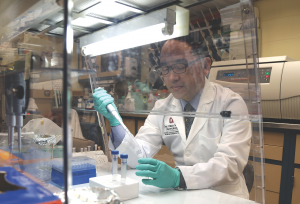
Ohio State veterinary students visit a turkey farm to learn about avian flu biosecurity. Outreach and education are key to protecting the poultry industry from infectious diseases.
Since November 2014, an outbreak of highly pathogenic avian influenza H5 spread by wild waterfowl has gripped the U.S. poultry industry, killing close to 50 million birds in at least 19 states.
While the virus has not yet reached Ohio, Ohio State University Extension experts have been helping poultry producers learn about the disease, boost biosecurity measures on the farm and prepare to minimize the flu’s impact if it were to reach the state.
“Our industry needs to adopt tighter biosecurity, as this virus can spread wide and fast, and outbreaks could reoccur in spring and fall,” said Mohamed El-Gazzar, OSU Extension poultry veterinarian. “We are also helping with logistical challenges such as identifying the best way to dispose of infected birds in case of an outbreak.”
To address this challenge, biosystems engineer Fred Michel developed a plan for Ohio egg farms to compost up to hundreds of thousands of dead chickens on-site, reducing the risk of contamination to other layer houses or nearby farms.
ESSENTIALS
• The current avian flu outbreak is a serious threat to Ohio’s $2.3 billion poultry industry, which directly supports more than 14,600 jobs. Nationally, Ohio ranks second in egg production and ninth in turkey production.
• If Ohio were to experience a poultry production loss of 50 percent, OSU Extension estimates the ripple effect would reach $1 billion in overall economic losses, including $815,000 in annual wages.
• Heavy losses to Iowa’s egg farms from this virus have sent egg prices soaring across the United States. If the virus reaches Ohio, prices will increase even more dramatically, affecting both consumers and food manufacturers.
More: go.osu.edu/birdflu
